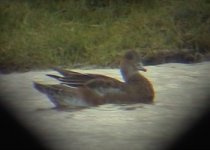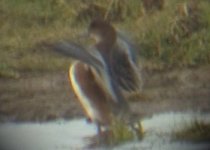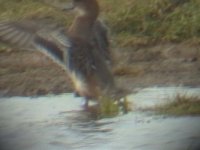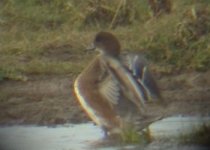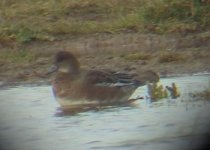Dear all,
Besides the 150 Black-Tailed Godwits, 4 Little Egrets, 80 Dunlin and single Ruff, Knot, Grey Plover and Golden Plover, I've been doing all I can to confirm the identity of a 'funny Wigeon' I first noticed on 5th November.
The summary of events is as follows:
At Oare Marshes on 5th November I found myself looking on the small scrape opposite the East Lagoon which is something I don't usually do. Having seen a flock of 150 Wigeon distantly on the West Lagoon (and a Bittern) I was surprised to see approximately 30 Wigeon 50metres from me and it was more by luck than anything else that I noticed a drab, nondescript female Wigeon with what appeared to be a slight mask effect over the eyes. There were other Wigeon in the group much the same to be honest and there was no logical reason why I chose to get my video camera out and digiscope this individual - nonetheless, I did.
Arriving home I watched the video and became more interested when I noticed that the wings appeared shorter than the other Wigeon it kept company with. Strange? My curiosity arroused I referred to the American Wigeon identification literature I had to hand ( Birding World and British Birds plus other identification guides) and one thing was apparent- if it were to be a female American Wigeon, I had to see the underwing which should be unmarked white.
So began the first of five return trips during which time I was nothing short of amazed to find the bird still on the small scrape but, worryingly, the flock had begun to change its habits - instead of keeping a high profile on the lagoon they had taken to hiding in the adjascent drainage ditch.
To cut a long story short, after numerous hours spent videoing the bird in a range of lighting conditions and becoming more convinced that the bird had potential as a female American, it was only today, Friday, when the Wigeon finally preened and (in comparatively dull light) majestically stretched its wings to their fullest extent and flapped several times that my suspicions appear to have been confirmed.
At home I played the tape and was relieved to see what appears to be unmarked white axillaries (tantalisingly glimpsed a few times previously with a quick flap but not completely revealed) and a lot of white in the underwing full stop.
To summarise, these are the features visible in the acompanying photos which, in my opinion, identify this bird as a 1st winter female American Wigeon:
1) White unmarked axillaries and underwings as a whole distinquish from Eurasian Wigeon.
2) The head and neck appear to be greyer than the rufous foreneck and flancks which, in good light, appear to have a more orange tint indicate the bird is a female.
3) There is a broad whitish greater covert bar which, upon closer inspection, reveals a greyish centred feathers indicating the bird is a 1st winter individual.
4) The rounded markings on the undertail coverts also confirm the bird is in it's 1st winter.
5) The wing tips do not reach the tail tip unlike Eurasian Wigeon which is a feature of American Wigeon. The bird gives the impression of having a longer tail than Eurasian Wigeon.
6) The uppertail coverts appear significantly pale with respect to the accompanying Eurasian Wigeons.
7) When in the water the head appears larger and with a different shape to that of the Eurasian Wigeons. The bird itself appears slightly bulkier too.
8) When flapping, the grey outer secondary feather can be seen - usually white in Eurasian Wigeon.
I realise that an immature female American Wigeon isn't a straightforward identification but, having scrutinised this bird in rain and shine, studied hours of video and researched more Internet pages than I care to mention, I feel I've gathered enough evidence to be able to stick my head above the parapet and 'go public'.
Two final points:
A) While I haven't found signs of it being an American x Eurasian hybrid, I can't be 100% sure.
B) It can be very difficult in some lights to be sure one is observing the correct bird - I video'd a lookalike myself today before realising the wings reached the tail tip!
If anyone has any comments/questions on this bird, I'd like to hear from you!
Best wishes,
Lancey
Besides the 150 Black-Tailed Godwits, 4 Little Egrets, 80 Dunlin and single Ruff, Knot, Grey Plover and Golden Plover, I've been doing all I can to confirm the identity of a 'funny Wigeon' I first noticed on 5th November.
The summary of events is as follows:
At Oare Marshes on 5th November I found myself looking on the small scrape opposite the East Lagoon which is something I don't usually do. Having seen a flock of 150 Wigeon distantly on the West Lagoon (and a Bittern) I was surprised to see approximately 30 Wigeon 50metres from me and it was more by luck than anything else that I noticed a drab, nondescript female Wigeon with what appeared to be a slight mask effect over the eyes. There were other Wigeon in the group much the same to be honest and there was no logical reason why I chose to get my video camera out and digiscope this individual - nonetheless, I did.
Arriving home I watched the video and became more interested when I noticed that the wings appeared shorter than the other Wigeon it kept company with. Strange? My curiosity arroused I referred to the American Wigeon identification literature I had to hand ( Birding World and British Birds plus other identification guides) and one thing was apparent- if it were to be a female American Wigeon, I had to see the underwing which should be unmarked white.
So began the first of five return trips during which time I was nothing short of amazed to find the bird still on the small scrape but, worryingly, the flock had begun to change its habits - instead of keeping a high profile on the lagoon they had taken to hiding in the adjascent drainage ditch.
To cut a long story short, after numerous hours spent videoing the bird in a range of lighting conditions and becoming more convinced that the bird had potential as a female American, it was only today, Friday, when the Wigeon finally preened and (in comparatively dull light) majestically stretched its wings to their fullest extent and flapped several times that my suspicions appear to have been confirmed.
At home I played the tape and was relieved to see what appears to be unmarked white axillaries (tantalisingly glimpsed a few times previously with a quick flap but not completely revealed) and a lot of white in the underwing full stop.
To summarise, these are the features visible in the acompanying photos which, in my opinion, identify this bird as a 1st winter female American Wigeon:
1) White unmarked axillaries and underwings as a whole distinquish from Eurasian Wigeon.
2) The head and neck appear to be greyer than the rufous foreneck and flancks which, in good light, appear to have a more orange tint indicate the bird is a female.
3) There is a broad whitish greater covert bar which, upon closer inspection, reveals a greyish centred feathers indicating the bird is a 1st winter individual.
4) The rounded markings on the undertail coverts also confirm the bird is in it's 1st winter.
5) The wing tips do not reach the tail tip unlike Eurasian Wigeon which is a feature of American Wigeon. The bird gives the impression of having a longer tail than Eurasian Wigeon.
6) The uppertail coverts appear significantly pale with respect to the accompanying Eurasian Wigeons.
7) When in the water the head appears larger and with a different shape to that of the Eurasian Wigeons. The bird itself appears slightly bulkier too.
8) When flapping, the grey outer secondary feather can be seen - usually white in Eurasian Wigeon.
I realise that an immature female American Wigeon isn't a straightforward identification but, having scrutinised this bird in rain and shine, studied hours of video and researched more Internet pages than I care to mention, I feel I've gathered enough evidence to be able to stick my head above the parapet and 'go public'.
Two final points:
A) While I haven't found signs of it being an American x Eurasian hybrid, I can't be 100% sure.
B) It can be very difficult in some lights to be sure one is observing the correct bird - I video'd a lookalike myself today before realising the wings reached the tail tip!
If anyone has any comments/questions on this bird, I'd like to hear from you!
Best wishes,
Lancey




